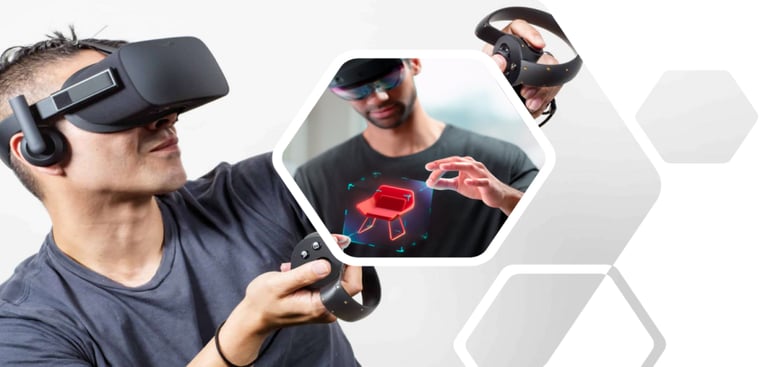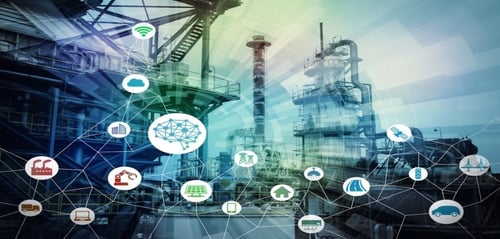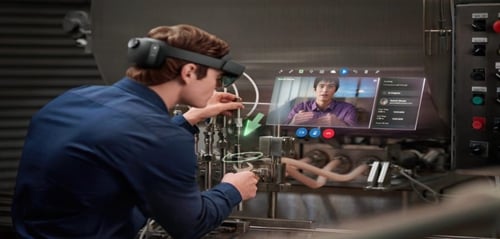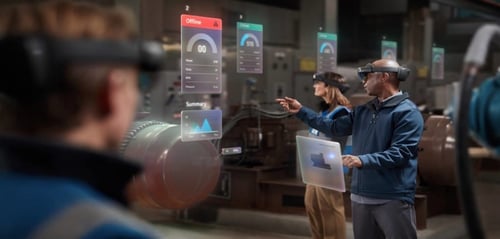More and more innovative technologies are becoming essential in the industrial sector thanks to their performance in the field. Among these technologies, we find three that have been emerging for a few years now. They are Virtual Reality, Augmented Reality and Mixed Reality.
Often confused or misused, we propose to clarify their origin and scope, in order to provide a better understanding of these three technologies.
Virtual Reality: a simple technology that has its limits
As its name suggests, this technology creates a reality that is completely virtual. Indeed, virtual reality (vr) allows you to create a world in which you can be totally immersed thanks to a virtual reality headset that will allow you to see the created universe, without any relation with the real world. To set up this simulation, the main devices are based on a technology of sound spatializationThis means that it allows you to hear sounds in "3D" and to be able to locate them around you, while having the impression of having a certain distance thanks to thevr glasses.
Virtual reality is often used in games because it allows you to create a fantastic but sufficiently realistic world or to reproduce an existing environment. It is also used in some companies to provide a better customer experience or to support employees. For example, in real estate, it is used to allow customers to visit their house before construction. Other businesses use vr to save time and money, while increasing the quality of the product or service.
Virtual reality has certain advantages for industrial companies. It allows the operator to be immersed in the environment he will be confronted with once in the field, making him aware of the gestures and risks before taking up his duties. To learn and master the process he has the possibility, thanks to the vr, to recreate an environment that stages a breakdown on a machine, and then to train by performing the scenario several times. However, there is a limit: in case of a real breakdown, the operator is not protected from forgetting or making a mistake during his intervention because with virtual reality there is no possibility of interacting with the real world.
Augmented Reality & Mixed Reality: not so different
Unlike virtual reality, augmented reality (ar) allows you to superimpose digital elements in your field of vision. Thanks to ar glasses (Microsoft's Hololens 2 for example) it is now possible to visualize digital elements in our environment.
The goal with an augmented reality solution is not to be immersed in a world but rather to superimpose digital elements (images, text, data) in reality. Perceived reality is augmented with digital information to bring more precision to the environment. For example, in the context of a machine check, the operator can, with the help of augmented reality glasses, carry out his control by scanning the machine with his eyes and having all the information at his disposal in front of his eyes. This is a technology that is widely used in companies, especially in the industrial sector.
The Spectral TMS augmented reality solution allows to accompany operators in production processes for example. AR has many advantages, especially in terms of handling, which is extremely simple. With the Spectral TMS augmented reality solution, you have the possibility to create user path in less than 30 minutes and view them immediately through the Augmented Reality Headset. It also allows operators, during their interventions, to have simultaneous access to the intervention processes, which is not the case with virtual reality. Operators also have complete freedom of movement, which allows them to act only on their equipment.
Mixed reality (mr) also called hybrid reality is a mixture of virtual reality and augmented reality. With mixed reality, you can produce a new environment and visualizations where physical objects from the real world and digital objects from the virtual world coexist and can interact in real time. By combining the two previous realities, it is possible to simulate real living elements in our field of vision. For example, in the medical sector, augmented realityallows the doctor during a surgical operation to visualize information over his patient's body.
Some consider mixed reality is an improved version of augmented reality because it allows to take into account real space and to calculate the user's position in real time. At Spectral TMS, we use mixed reality which is a technology often used by professionals, especially in the industrial sector. Thanks to Hololens 2 glasses, a technology from the giant Microsoft, operators can superimpose digital elements during their interventions and thus intervene quickly, which saves them precious time.
If you would like more information, please contact us at contact@spectraltms.com or take an appointment in video conference with one of our experts.
Published:
By: Spectral TMS



